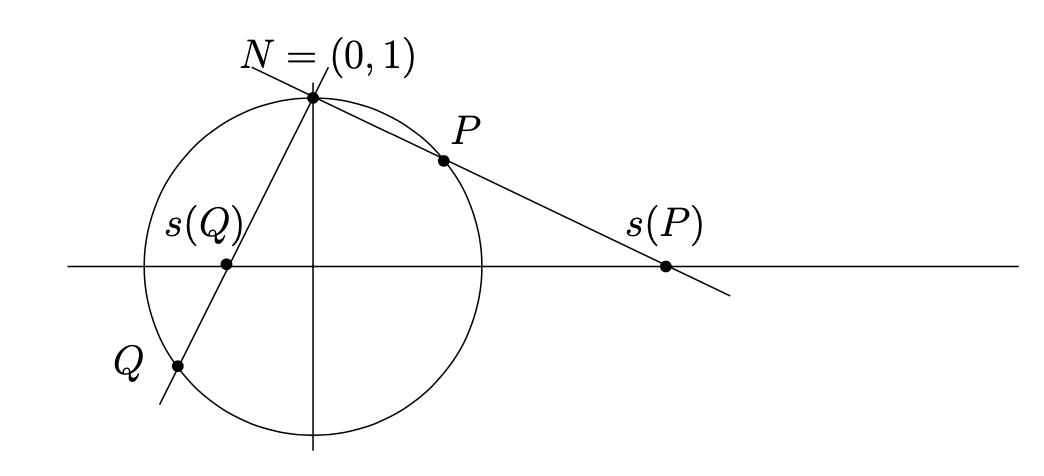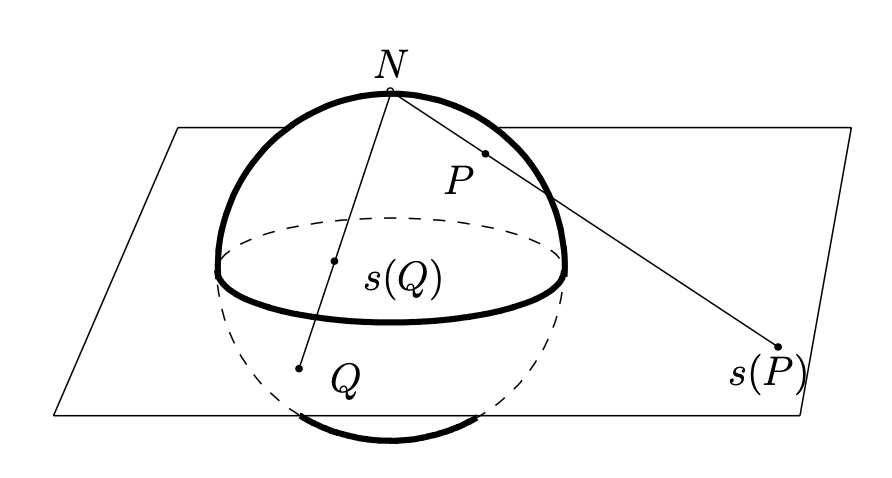1.3: Stereographic Projection
( \newcommand{\kernel}{\mathrm{null}\,}\)
Stereographic projection S1→ˆR
Let S1 denote the unit circle in the x,y-plane.
S1={(x,y)∈R2:x2+y2=1}
Let N=(0,1) denote the "north pole" (that is, the point at the "top" of the unit circle). Given a point P=(x,y)≠N on the unit circle, let s(P) denote the intersection of the line ¯NP with the x-axis. See Figure 1.3.1. The map s:S1∖{N}→R given by this rule is called stereographic projection. Using similar triangles, it is easy to see that s(x,y)=x1−y.

- Checkpoint 1.3.2.
-
Draw the relevant similar triangles and verify the formula s(x,y)=x1−y.
We extend stereographic projection to the entire unit circle as follows. We call the set
ˆR=R∪{∞}
the extended real numbers, where "∞" is an element that is not a real number. Now we define stereographic projection s:S1→ˆR bys(x,y)={x1−yy≠1∞y=1.
Stereographic projection S2→ˆC
The definitions in the previous subsection extend naturally to higher dimensions. Here are the details for the main case of interest.
Let S2 denote the unit sphere in R3.
S2={(a,b,c)∈R3:a2+b2+c2=1}
Let N=(0,0,1) denote the "north pole" (that is, the point at the "top" of the sphere, where the positive z-axis is "up"). Given a point P=(a,b,c)≠N on the unit sphere, let s(P) denote the intersection of the line ¯NP with the x,y-plane, which we identify with the complex plane C. See See Figure 1.3.3. The map s:S2∖{N}→C given by this rule is called stereographic projection. Using similar triangles, it is easy to see that s(a,b,c)=a+ib1−c.

We extend stereographic projection to the entire unit sphere as follows. We call the set
ˆC=C∪{∞}
the extended complex numbers, where "∞" is an element that is not a complex number. Now we define stereographic projection s:S2→ˆC by
s(a,b,c)={a+ib1−cc≠1∞c=1.
Exercises
Formulas for inverse stereographic projection.
It is intuitively clear that stereographic projection is a bijection. Make this rigorous by finding a formula for the inverse.
For s:S1→ˆR, find a formula for s−1:ˆR→S1. Find s−1(3).
- Answer
-
s−1(r)={(2rr2+1,r2−1r2+1) if r≠∞(0,1) if r=∞
s−1(3)=(3/5,4/5)
For s:S2→ˆC, find a formula for s−1:ˆC→S2. Find s−1(3+i).
- Answer
-
s−1(z)={(2Re(z)|z|2+1,2Im(z)|z|2+1,|z|2−1|z|2+1) if z≠∞(0,0,1) if z=∞
s−1(3+i)=(6/11,2/11,9/11)
Conjugate transformations.
Let μ:X→Y be a bijective map. We say that maps and f:X→X and g:Y→Y are conjugate transformations (with respect to the bijection μ) if f=μ−1∘g∘μ.
Show that the maps S1→S1 given by (x,y)→(x,−y) and ˆR→ˆR given by x→1/x are conjugate transformations with respect to stereographic projection
Show that the map RZ,θ:S2→S2 given by (a,b,c)→(acosθ−bsinθ,asinθ+bcosθ,c) (a rotation about the z-axis by angle θ) and the map TZ,θ:ˆC→ˆC given by z→eiθz are conjugate transformations with respect to stereographic projection.
Show that the map RX,π:S2→S2 given by (a,b,c)→(a,−b,−c) (rotation about the x-axis by π radians) and the map TX,π:ˆC→ˆC given by z→1/z are conjugate transformations with respect to stereographic projection.
Show that the map RX,π/2:S2→S2 given by (a,b,c)→(a,−c,b) (rotation about the x-axis by π/2 radians) and the map TX,π/2:ˆC→ˆC given by z→z+iiz+1 are conjugate transformations with respect to stereographic projection.
7. Projections of endpoints of diameters.
Show that s(a,b,c)(s(−a,−b,−c))∗=−1 for any point (a,b,c) in S2 with |c|≠1. Conversely, suppose that zw∗=−1 for some z,w∈C. Show that .


